Founded in 2011, Kampachi Farms conducted the first-ever trial of open ocean aquaculture in US Federal Waters and is currently developing deep-sea technology to produce sashimi-grade Kampachi (also known as yellowtail or Seriola). Its research also focuses on alternative feeds, while work is underway to establish a new commercial grow-out site in Bahía de La Paz, Mexico.
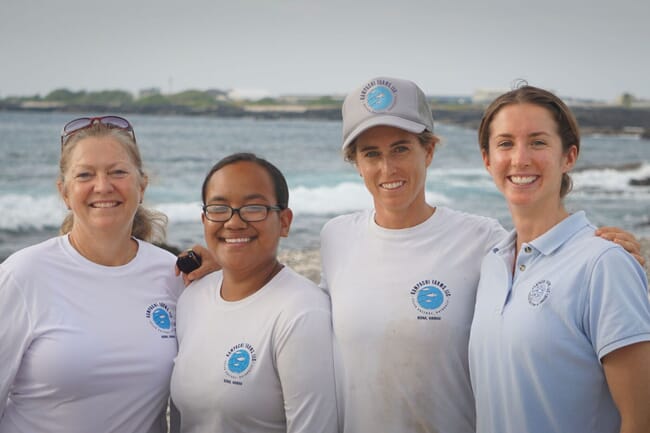
The female staff at Kampachi Farms have significant roles in the operation. We spoke to Research Manager Lisa Vollbrecht, Office Manager Lucie Leonard, Research Technician Helen Meigs and Kampachi Intern Taimane Ulu to learn more about their work and how they got to where they are today.
Briefly describe your aquaculture careers
Lisa: I began in the research field, and I’ve now been working on technologies to advance the offshore aquaculture industry for over three years. Today, I manage the Kampachi Farms research programme (overseeing all of our research activities) but I didn’t start here. I worked in aquaria for several years while looking for my opportunity to get involved in this industry. When the opportunity arose, I entered as a technician, doing things like scrubbing tanks, cleaning filters and feeding fish. As I learned, my role grew to include broodstock husbandry, larval rearing and live feeds.
Lucie: I have been working in the accounting and HR field for 20 years, and supporting Kampachi Farms for the last ten.
Helen: Kampachi Farms offers me the opportunity to focus on improving industry sustainability from all angles. We research alternative feed ingredients, selective breeding, new species for aquaculture and novel cage configurations for open ocean farming.
Taimane: Although I'm just starting out in aquaculture, I first got to work with aquatic animals as a high school student at West Hawaii Explorations Academy. There, I had hands on experience with our two black tip reef sharks. I also work on breeding clownfish and raising their offspring. This has set me up well for the Kampachi Farms internship, where I do a lot of fish husbandry and need to be comfortable getting in the tanks with some very large fish.
What inspired you to start in aquaculture?
Lisa: I came to aquaculture from a farming and conservation-focused background, as many of us do. Spending my upbringing in a rural farming community provided me with a visceral understanding of the responsibility and significance of food production. I completed a degree in Marine and Freshwater Biology, which fuelled my fascination and curiosity about our aquatic environments, and spent several summers locating critical habitats for conservation of species at risk in the Great Lakes region. The first time I experienced the ocean, I was captivated. I naturally gravitated towards marine conservation, and this ultimately brought me into aquaculture. The seafood demands of our growing global population can’t reliably be met without aquaculture. Thus, responsible growth of the aquaculture industry is an active solution.
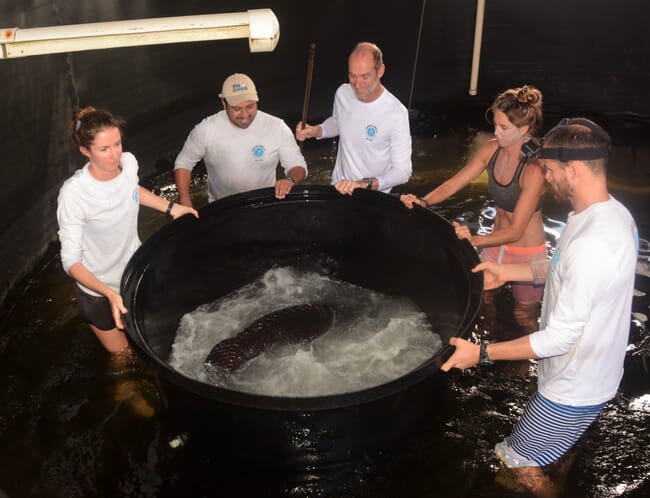
Helen: I started my marine science career path in environmental monitoring, which proved discouragingly passive - becoming ever more aware of threats to marine resources and writing assessments which may or may not be heeded. I found aquaculture as the way to actively produce the resources we do so much damage to catch, and a way to use science toward a solution, not merely a report. It also happens that I like fish, I like getting my hands dirty, and I like to know where my food comes from; producing my own seafood is the trifecta of good eating.
Taimane: I wanted to learn more about how the fish were raised in captivity, and I wanted to know what some of the challenges were that the workers would stumble upon, and how they would work it out.
Describe a typical day in your current role
Lisa: There can be quite a lot of variety in my day-to-day activities, including planning research activities, providing direction and leadership to our research team to execute work plans, advancing communications with our public and private partners, and (occasionally, nowadays) handling the fish.
Lucie: I am all about the financial side. Most of our funds are research grants. We are subject to scrutiny by all our funding agencies. Most require periodic reporting and some require financial draws based on these reports. The reporting requirements vary by agency. Of course, we also have a small group of dedicated employees who have the normal human resource needs.
Helen: As a research facility, project turnover/evolution keeps things interesting and makes my role anything but typical. When we produce larvae to supply new trials I lead hatchery operations – live feed production, feeding and maintenance regimens, a healthy amount of bucket scrubbing. Additionally, I analyse data for active grow-out trials and use this to guide the next steps in R&D. Any other time is spent helping with broodstock maintenance (diet prep, retrieving wilds), or site maintenance (plumbing, re-plumbing, an inordinate amount of pick-axing).
Taimane: A typical day at Kampachi Farm involves helping with feeding, food preparation, and cleaning of tanks.
What’s the most inspiring experience you’ve had working in aquaculture to date?
Lisa: Offshore aquaculture is on the cusp of rapid expansion, and I feel very fortunate to be working in such a passionate and resourceful community. I’m often inspired!
Lucie: What inspires me is knowing I am part of a dedicated, focused and experienced group of people from various walks and places in life who are committed to being part of the search for more sustainable feeds and fish in an industry that has the potential to be a powerful player in the world's need for food in an ever-growing population.
Helen: An early experience that got me hooked on the industry was the opportunity to try my hand at larval rearing of Pandalus platyceros (aka spot prawn, amaebi). I was completely left to my own devices to build kreisel tanks, soda-bottle artemia setups, etc. and was left with a modest number of post-larvae to show for it. It was exceptionally basic and small scale, but the satisfaction of growing something so useful has stuck with me.
What's the most unusual experience you've had?
Lisa: Honestly, I don’t classify too many experiences as unusual. Working in aquaculture keeps you on your toes - and working in the rapidly changing research field even more so. You take things as they come.
Lucie: Unlike other industries I've worked in, here, I get to taste a lot of sushi and my input really counts!
Helen: Testing my breath hold to retrieve some juvenile fish that had firmly lodged themselves in a drain line with no intention of coming out quietly. That was a good one. But in general, 'unusual" is the norm.
How important are sustainability concerns to you and how do you address them in your work?
Lisa: Our mission is to expand the environmentally sound production of the ocean’s finest fish, which is grounded in sustainability. This sense of stewardship is important through my work and personal life.
Lucie: My field of work is very heavy on paper. There is a constant need to keep accurate and detailed records. But computers and software are an important tool in minimising waste.
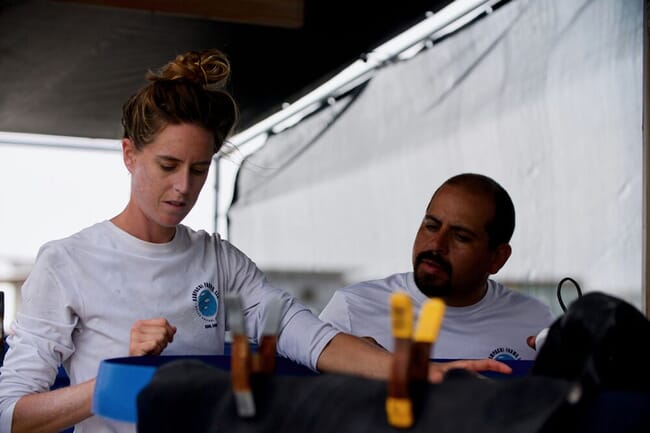
Helen: Sustainability concerns brought me into this field and the overarching goal of reducing overexploitation keeps work meaningful. All our projects are designed to improve the sustainability of aquaculture from one angle or another; be it decreasing dependence on fish oil, establishing rearing protocols for new species and optimising those of market species, or testing novel open ocean cage configurations.
What new technical or product innovation do you think has the most potential to change the industry?
Lisa: Genomic technologies that support selective breeding. I can’t think of a commercially farmed protein source that hasn’t been selectively bred. In finfish aquaculture, we have a relatively recent timeline compared with the 10,000 year-old history of selective breeding in terrestrial agriculture. Molecular technologies to identify genetic markers for commercially important traits and screen potential broodstock are enabling rapid improvement in selective breeding outcomes. There are many researchers collaborating on this work in Seriola, including Kampachi Farms, and we’ve already seen tremendous potential to improve growth and health in commercial culture. I think there is also great potential for the technologies supporting a proactive health management approach (through nutrition, microbiome considerations, and overall best management practices).
Lucie: Some of the new sustainable fish feeds being developed.
Helen: The technologies allowing us to move offshore, which is the only way to possibly expand production enough in an environmentally sound manner.
Have you seen the opportunities for women improve in your region in recent years?
Helen: I am relatively new to this part of the world and have been fortunate enough to have not experienced inequality here. My team is almost 50 percent women, and they are well respected throughout the company and among our collaborators. My work environment is a testament to an era of improved opportunity for women, and an example of the success that can be achieved in a diverse workplace.
What advice would you give to women looking to start a career in the sector?
Lisa: Don’t think of yourself as different from anyone else. Be observant of what needs to be done and apply yourself to the task at hand. There are no gender-specific jobs. Just jobs. Welcome; you belong; let’s get to work.
Lucie: Start with an internship- multiple internships - so you can see if you really enjoy this area. Be prepared to start at the bottom and learn upwards.
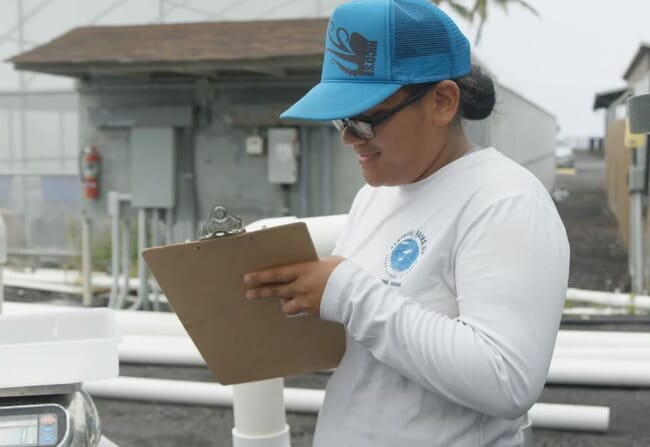
Helen: This industry needs more passionate individuals to sustainably meet demand. Farmers, engineers, biologists, fishermen, businessmen, programmers, marketers, geneticists; aquaculture is multidimensional, and progress comes from all of these dimensions. Regardless of direct prior aquaculture experience, your existing skillset will be of value in one area or another, and you will learn an awful lot from colleagues about the rest. Dig in."
What would be your dream role in aquaculture and do you think it’s realistic to achieve?
Helen: I want to see an increase in the variety of farmed finfish. To facilitate this, I personally want to excel at spawning and rearing new species. I guess my dream role includes establishing initial market feasibility of candidate species, as well as consulting for prospective farms to jumpstart production. But this field is changing fast (for the better!), so who knows?
What has been the aquaculture industry’s greatest accomplishment in recent years?
Lisa: On a global scale, I would say the growing recognition for, and adoption of, best management practices and standards. There have been many accomplishments in the application of emerging technologies in system designs, husbandry, feeds, automation, and processing that will further the environmentally responsible growth of our industry. Aquaculture, when sited properly and managed responsibly, has minimal impact on the environment. Getting this message to the public in an effective way will be the next great accomplishment.
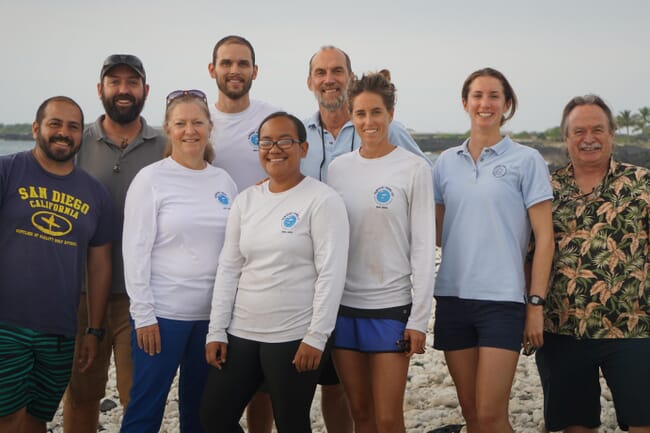
What outstanding challenge would you most like to solve?
Lisa: In the US, I’d like to see the barriers to expansion of offshore aquaculture addressed - specifically, permitting. Historically, the process has been nebulous, daunting, and dissuasive for farmers and investors. Permitting is also closely tied to public perceptions (and, perhaps, misperceptions) about aquaculture. Fortunately, there are many bright minds working together to improve both of these elements of the industry. The climate is changing now. Kampachi Farms is also taking action in this vein. Currently, we are in the process of applying for permits to station a demonstration net-pen operation in the Gulf of Mexico, and creating a step-by-step permitting guide for others to follow. This demonstration will be an accessible example of offshore aquaculture, which will serve as a platform for increasing public awareness of, and receptivity towards, offshore aquaculture and the need to culture more seafood in US waters.






